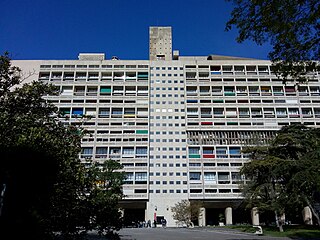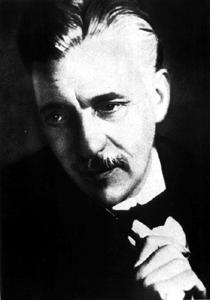
An apartment, flat, or unit is a self-contained housing unit that occupies part of a building, generally on a single story. There are many names for these overall buildings. The housing tenure of apartments also varies considerably, from large-scale public housing, to owner occupancy within what is legally a condominium or leasehold, to tenants renting from a private landlord.

The Unité d'habitation is a modernist residential housing typology developed by Le Corbusier, with the collaboration of painter-architect Nadir Afonso. It formed the basis of several housing developments throughout Europe designed by Le Corbusier and sharing the same name.
The year 1932 in architecture involved some significant events.

The Seven Sisters are a group of seven skyscrapers in Moscow designed in the Stalinist style. They were built from 1947 to 1953. At the time of construction, they were the tallest buildings in Europe, and the main building of Moscow State University remained the tallest building in Europe until 1990.
Panelák is a colloquial term in Czech and Slovak for a large panel system panel building constructed of pre-fabricated, pre-stressed concrete, such as those extant in the former Czechoslovakia and elsewhere in the world. Paneláks are usually located in housing estates.

Inspied by the ideologies of Soviet Constructivist theory, the social condenser is an architectural form defined by its influence over spatial dynamics. In the opening speech of the inaugural OSA Group conference in 1928, Moisei Ginzburg claimed that "the principal objective of constructivism... is the definition of the Social Condenser of the age." The single building most associated with the idea is the Narkomfin Building in Moscow, for which construction began in 1928 and finished in 1932.

Stalinist architecture, mostly known in the former Eastern Bloc as Stalinist style or socialist classicism, is the architecture of the Soviet Union under the leadership of Joseph Stalin, between 1933 and 1955. Stalinist architecture is associated with the Socialist realism school of art and architecture.

Communal apartments are apartments in which several unrelated persons or families live in isolated living rooms and share common areas such a kitchen, shower, and toilet. When the Bolsheviks came to power in 1917 after the October Revolution, to cope with the housing shortage, they nationalised luxurious apartment blocks from rich people to make them available to the proletariat.

Tverskaya Street, known between 1935 and 1990 as Gorky Street, is the main radial street in Moscow. The street runs Northwest from the central Manege Square in the direction of Saint Petersburg and terminates at the Garden Ring, giving the name to Tverskoy District. The route continues further as First Tverskaya-Yamskaya Street, Leningradsky Avenue and Leningradskoye Highway.

Alexander Aleksandrovich Vesnin, together with his brothers Leonid and Viktor, was a leading light of Constructivist architecture. He is best known for his meticulous perspectival drawings such as Leningrad Pravda of 1924.

Khrushchevkas are a type of low-cost, concrete-paneled or brick three- to five-storied apartment building which were designed and constructed in the Soviet Union since the early 1960s. Khrushchevkas are sometimes compared to the Japanese danchi, similar housing projects from the same period, which by some accounts were directly inspired by them.

Moisei Yakovlevich Ginzburg was a Soviet constructivist architect, best known for his 1929 Narkomfin Building in Moscow.

Constructivist architecture was a constructivist style of modern architecture that flourished in the Soviet Union in the 1920s and early 1930s. Abstract and austere, the movement aimed to reflect modern industrial society and urban space, while rejecting decorative stylization in favor of the industrial assemblage of materials. Designs combined advanced technology and engineering with an avowedly communist social purpose. Although it was divided into several competing factions, the movement produced many pioneering projects and finished buildings, before falling out of favor around 1932. It has left marked effects on later developments in architecture.

Ilya Alexandrovich Golosov was an architect from the late Russian Empire and early Soviet Union. A leader of Constructivism in 1925-1931, Ilya Golosov later developed his own style of early stalinist architecture known as postconstructivism. Не was a brother of Panteleimon Golosov.

The House on the Embankment is a block-wide apartment building on the banks of the Moskva River on Balchug in downtown Moscow, Russia. It faces Bersenevskaya Embankment on one side and Serafimovicha Street on the other side. Until 1952, it was the tallest residential building in Moscow. It is considered an example of constructivist architecture. It was best known as the place of residence of the Soviet elite, many of whom were arrested and executed during Stalin's Great Purge.

Postconstructivism was a transitional architectural style that existed in the Soviet Union in the 1930s, typical of early Stalinist architecture before World War II. The term postconstructivism was coined by Selim Khan-Magomedov, a historian of architecture, to describe the product of avant-garde artists' migration to Stalinist neoclassicism. Khan-Magomedov identified postconstructivism with 1932–1936, but the long construction time and vast size of the country extended the period to 1941.

The OSA Group was an architectural association in the Soviet Union, which was active from 1925 to 1930 and considered the first group of constructivist architects. It published the journal SA. It published material by Soviet and overseas contributors. However this led to them being attacked as a 'Western' group and some individuals as being 'bourgeois'. After the closure of the group, their modernist approach to architecture and town planning was eliminated in the Soviet Union by 1934, in favour of social realism.

Nikolay Alexandrovich Milyutin, alternatively transliterated as Miliutin was a Russian trade union and Bolshevik activist, participant in the October Revolution in Petrograd and Soviet statesman and architect. After the revolution Milyutin held various executive appointments in Soviet Russia related to social security, urban and central planning and finance; reaching that of Commissar of Finance of the RSFSR in 1924–1929. Milyutin is, however, remembered as an urban planner and an amateur architect, author of Sotsgorod concept, and as the editor of Sovetskaya arkhitektura magazine in 1931–1934.

Contemporary Architecture was a Soviet architectural journal published in Moscow. The journal ran from 1926 to 1930, releasing six issues per year, with occasional publications of "double issues." It was published by the OSA Group, a group of constructivist architects. Contemporary Architecture served as a platform for presenting and illustrating the constructivists' project of revolutionizing residential living for a socialist society in the twentieth century and put forward new ideas on numerous theoretical topics and innovative new projects in the field of architecture.

The single-kitchen home was a reform model of urban residential development in which a centrally managed canteen kitchen within a multi-party house replaced the kitchens of the individual apartments. The concept was based on the ideas of the women's rights activist and social democrat Lily Braun. With the basic idea of liberating women from housework, at the beginning of the 20th century it was an explicit counter-design to the establishment of the isolated nuclear family in mass housing. Single-kitchen houses, sometimes also called central kitchen houses, were implemented in various European large cities in isolated and different ways until the 1950s. As key works of an idea of modern living, some of these buildings were nominated for the European Heritage Label in 2009, expressly as a network of common European architecture spread across various countries.





























